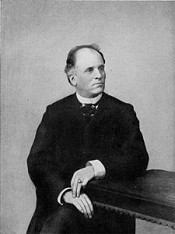Bandelier Adolph Francis Alphonse

Adolph Francis Alphonse Bandelier (August 6, 1840 – March 18, 1914) was an American archaeologist after whom Bandelier National Monument in New Mexico is named. Bandelier was born in Bern, Switzerland. When a youth he emigrated to the United States. As a young man he labored unhappily in his family business. Under the mentorship of the pioneering anthropologist Lewis Henry Morgan he turned to scholarship, more particularly to archaeological and ethnological work among the Indians of the southwestern United States, Mexico and South America. Beginning his studies in Sonora (Mexico), Arizona and New Mexico, he made himself the leading authority on the history of this region, and — with F. H. Cushing and his successors — one of the leading authorities on its prehistoric civilization. In 1892 he abandoned this field for Ecuador, Bolivia and Peru, where he continued ethnological, archaeological and historical investigations. In the first field he was in a part of his work connected with the Hemenway Archaeological Expedition and in the second worked for Henry Villard of New York, and for the American Museum of Natural History of the same city. Bandelier had shown the falsity of various historical myths, notably in his conclusions respecting the Inca civilization of Peru.
do you like this author?
What readers are saying
What do you think? Write your own comment on this book!
write a commentWhat readers are saying
What do you think? Write your own comment on this author!
write a commentBook list

Historical Introduction to Studies Among the Sedentary Indians of New Mexico; Report on the Ruins of the Pueblo of Pecos
Papers Of The Archæological Institute Of America,American Series,Vol. I
Series:
Unknown
Year:
Unknown
Raiting:
3/5
Show more
add to favoritesadd In favorites

Documentary History of the Rio Grande Pueblos of New Mexico; I. Bibliographic IntroductionPapers of the School of American Archaeology,No. 13
Series:
Unknown
Year:
Unknown
Raiting:
3/5
Show more
add to favoritesadd In favorites

Historical Introduction to Studies Among the Sedentary Indians of New Mexico; Report on the Ruins of the Pueblo of Pecos
Series:
Unknown
Year:
Unknown
Raiting:
4.5/5
Show more
add to favoritesadd In favorites
Book list

Historical Introduction to Studies Among the Sedentary Indians of New Mexico; Report on the Ruins of the Pueblo of Pecos
Papers Of The Archæological Institute Of America,American Series,Vol. I
Series:
Unknown
Year:
Unknown
Raiting:
3/5
Show more
add to favoritesadd In favorites

Documentary History of the Rio Grande Pueblos of New Mexico; I. Bibliographic IntroductionPapers of the School of American Archaeology,No. 13
Series:
Unknown
Year:
Unknown
Raiting:
3/5
Show more
add to favoritesadd In favorites

Historical Introduction to Studies Among the Sedentary Indians of New Mexico; Report on the Ruins of the Pueblo of Pecos
Series:
Unknown
Year:
Unknown
Raiting:
4.5/5
Show more
add to favoritesadd In favorites

Documentary History of the Rio Grande Pueblos of New Mexico; I. Bibliographic Introduction
Series:
Unknown
Year:
Unknown
Raiting:
3.5/5
Show more
add to favoritesadd In favorites

The Delight Makers
Series:
Unknown
Year:
Unknown
Raiting:
3.5/5
Originally published in 1916. This volume from the Cornell University Library's print collections was scanned on an APT BookScan and converted to JPG 2000 format by Kirtas Technologies. All titles scanned cover to cover and pages may include marks notations and other marginalia present in the original volume.
Show more
add to favoritesadd In favorites
What readers are saying
What do you think? Write your own comment on this author!
write a commentif you like Bandelier Adolph Francis Alphonse try:
readers also enjoyed
What readers are saying
What do you think? Write your own comment on this author!
write a commentGenre
if you like Bandelier Adolph Francis Alphonse try:
readers also enjoyed
Do you want to read a book that interests you? It’s EASY!
Create an account and send a request for reading to other users on the Webpage of the book!

